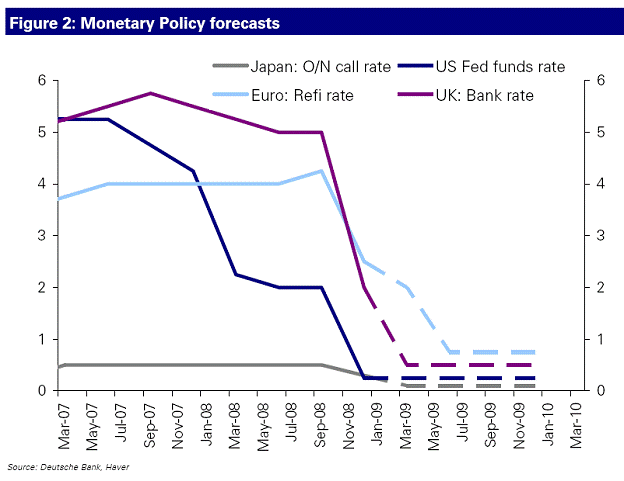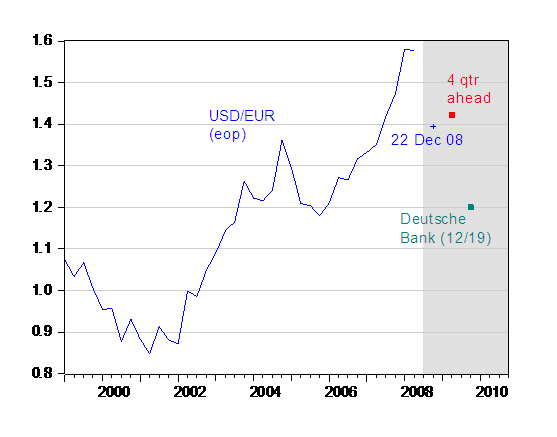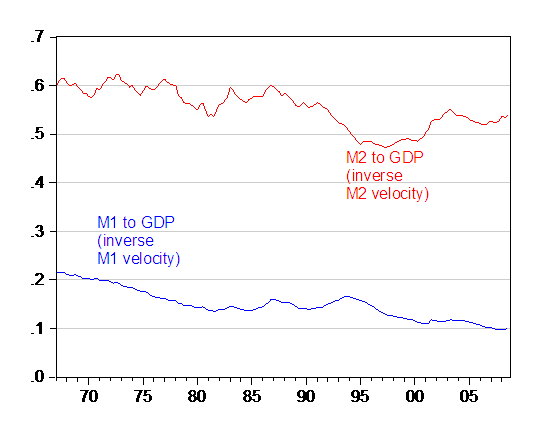Several months ago, I discussed the implications of a model of the exchange rate wherein Taylor rule fundamentals — the output [0], inflation and exchange rate gaps — were central (post). In that paper [pdf], I showed that Taylor rule fundamentals outperformed purchasing power parity, interest rate parity, and the monetary model of exchange rates in terms of in-sample fit, at least insofar as the dollar/euro exchange rate is concerned.
Other authors have found the Taylor rule worked well for other currencies, including the dollar/euro, in out-of-sample forecasting experiments [1], [2].
Unfortunately, events have outrun modeling. Policy rates in the key economies have either already hit zero (Japan, US) or are forecast to (UK, euro area).

Figure 2 from B. Chadha, “Quant Easting and the Dollar,” Global Economic Perspectives (Deutsche Bank, 19 December 2008), not online.
Now, remember the steps involved in getting a relationship between the exchange rate and these “gaps”. The gaps are related to changes in the policy rates; the policy rates are linked to expected appreciation (not depreciation) since prices are sticky (the Dornbusch-Frankel model).
This leads to the following specification for the four quarter change in the dollar/euro exchange rate of the following form:
st-st-4 = 0.114 – 7.072 ogt-4 – 4.790 πt-4 + 0.313 qt-4 – 9.982 (q3)t-4 + 1.381 it-5 + ut
where adj.R2 = 0.89, SER = 0.052, sample 1999q1-08q1
And where the output gap (og) is measured as a deviation from a quadratic trend applied to real GDP data, the underlying Taylor rule incorporates an output gap, and inflation gap (π), a real exchange rate gap (q), and the interest rate (i) responds nonlinearly with respect to the exchange rate gap. The one-year-ahead forecast (for data ending 2008Q2, as discussed in this post) is shown in Figure 2, with the 22 December observation on the USD/EUR rate, and the Deutsche Bank forecast from 12/19 for one-year-ahead. So far, the actual, forecast still seems plausible.

Figure 2: Dollar/euro rate (blue), 22 December observation (blue +), in-sample 4 quarter ahead prediction from Taylor rule fundamentals estimated over 1999q1-08q2 (solid red square) and DB forecast for 12/18/09 (teal square). Source: author’s calculations and Deutsche Bank Exchange Rate Perspectives, December 19, 2008.
But now the link is broken, as the interest rate is no longer a policy instrument. It is true that long term interest rates can still be influenced by policymakers, but not via the term structure. Rather, for the near future, policy will be effected via quantitative easing. This breaks the obvious link between the fundamentals and the exchange rate.
I don’t have a good answer for what will work in future. One could go back to the monetary model of the exchange rate (discussed here). And this has the advantage of using money stocks, which are observable (as opposed to unobservables like output and inflation gaps). On the other hand, the model also presupposes a stable relationship between money, interest rates and incomes, something that those familiar with the money demand literature will know is difficult to show.

Figure 3: M1 to GDP ratio (blue) and M2 to GDP ratio (red), all series seasonally adjusted. Source: BEA, GDP release of 25 November, and Federal Reserve Board via St. Louis Fed FRED II.
This point actually leads me to another, more general, observation. Many of the monetary policy multipliers are based upon the supposition that the interest rate can be moved in either direction to influence aggregate output. However, as we’ve come to the zero interest bound, this supposition can no longer be supported. Perhaps, we’ll have to move back to defining monetary policy multipliers in terms of money aggregates, instead of in terms of policy rate changes [4], not that these monetary policy multipliers will look like those that would obtain in normal times (see Krugman’s take here [pdf]). In any case, modeling monetary policy effects in this new environment will likely be one of the major challenges for macro modelers going forward.
Technorati Tags: zero interest rate policy, ZIRP, exchange rates,
Taylor rule, and monetary policy multiplier.
Forgive my ignorance, but I thought quantitative easing was the way the Fed reached its target interest rate, and any effects that this “target setting” had before the treasuries were converted into cash were due to banks realizing that the Fed would get the rate they wanted anyway. What’s the distinction? Or where’s my disconnect?
I believe Deutche Bank will be pretty close to the money.
Menzie:
Krugman’s .pdf appears to be missing the figure’s he references. Is there any way to get these?
Daniel: I think you are confusing the general proposition that one cannot target simultaneously both the interest rate and the money stock. However, when the interest rate hits the zero interest rate (lower) bound, then this proposition no longer holds; then monetary policy can be effected by quantitative targetting of the money stock.
Ian: If you use scholar.google, you’ll get this link to the published version, which does have the graphs.
Deflation, Reflation, Inflation, OR ALL THREE is the title of the new post at http://www.stockshotz.blogspot.com
Check out the article as these guys outline why they think inflation is on the way and how the deflation in prices that we have seen lately is going to actually contribute to inflation in the near future. This post is not what I wanted to hear, but it made me think.
I don’t pay much attention to currencies. But all currency crisis occur for mainly one reason:
If the world’s largest economy ($14b+) has an economic slowdown, or contraction; U.S. imports will fall, & export driven countries will suffer (didn’t someone descibe this as coupling?).
An economic collapse in the U.S. will exacerbate any decline, stoppage, or reversal (negative) in international trade (flow of funds), and any currency crisis (or drop in the exchange value of the dollar).
Listed below is a partial list, i.e., currency crisis that were predictable & preventable
(1) Black Monday Oct 19 1987 (same day)
(2) Mexico Peso crisis Dec 1994 (2 months early) Peso was pegged
(3) U.S. dollar/Yen fall (3%) in Mar. 1995 (same month) (record trade deficit)
(4) Asian financial crisis July 1997 (one month late) – without primary time series
(5) Russian financial crisis Aug 1998 (same month)
These crisis were all the direct fault of our Federal Reserve Board monetary policies.
Since 2000, the dollar has rose, then fell. The trends are impossible to miss.
Traders sell or buy when the rate-of-change in legal reserves fall or rise (principally for no other reason). The FED’s technical staff doesn’t know how to forecast.
There is no such animal as a variable economic lag in the U.S. There is only universal economic ignorance. All lags are exactly the same.
I am happy for you take an opportunity to explain your political view combined with your expertise in economics.
Whether that combination interests me need not effect your taking that opportunity.
The fact only your economic analysis interests me must dictate my decision on whether to read your discourse.
Should you continue to exercise your option to combine your politics with your economics, I will choose to stop reading your posts.
Best luck.
Bill: ok. Not sure what the political component in this post is, though.
A Specific Application of Employment, Interest and Money
Plea for an Adventure in a New World Economic Order
Adam Smith, Karl Marx, John Maynard Keynes and Alan Greenspan: a Unified Perspective
Abstract:
This tract makes a critical analysis of credit based, free market economy, Capitalism, and proves that its dysfunctions are the result of the existence of credit.
It shows that income / wealth disparity, cause and consequence of credit, is the first order hidden variable, possibly the only one, of economic development.
It solves most of the puzzles of macro economy: among which Business Cycles, Stagflation, Greenspan Conundrum and Keynes’ Liquidity Trap…
It shows that Adam Smith, John Maynard Keynes, Karl Marx and Alan Greenspan don’t contradict each other but that they each bring a meaningful contribution to a same framework for understanding macro economy.
It proposes a credit free, free market economy as a solution that would correct all of those dysfunctions.
In This Age of Turbulence People Want an Exit Strategy out of Credit, an Adventure in a New World Economic Order.
Read It.